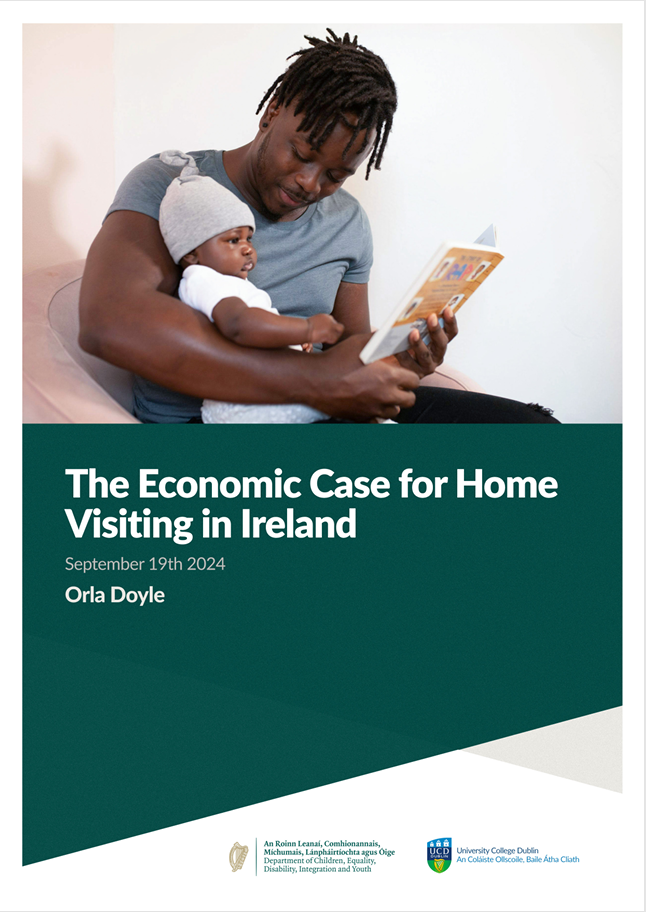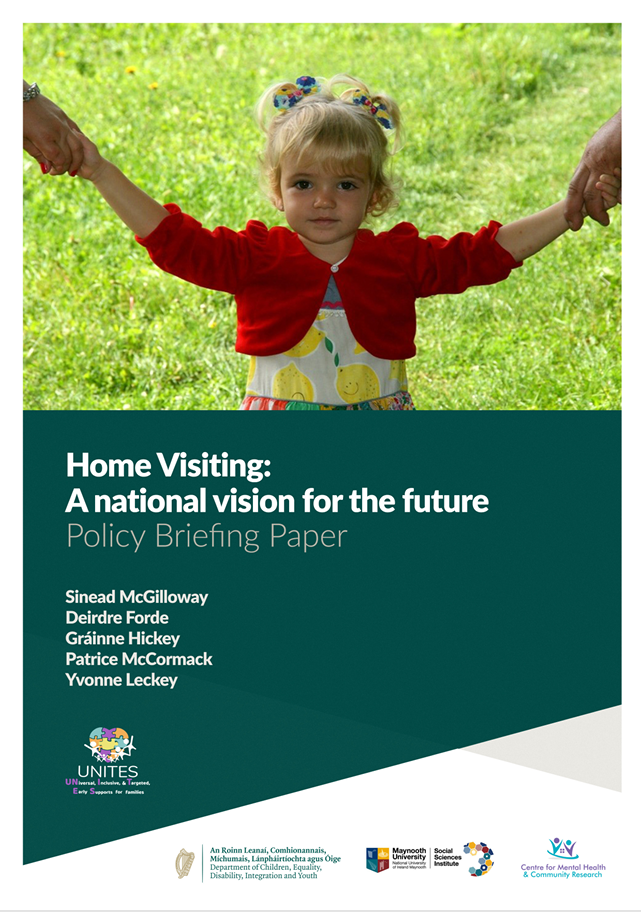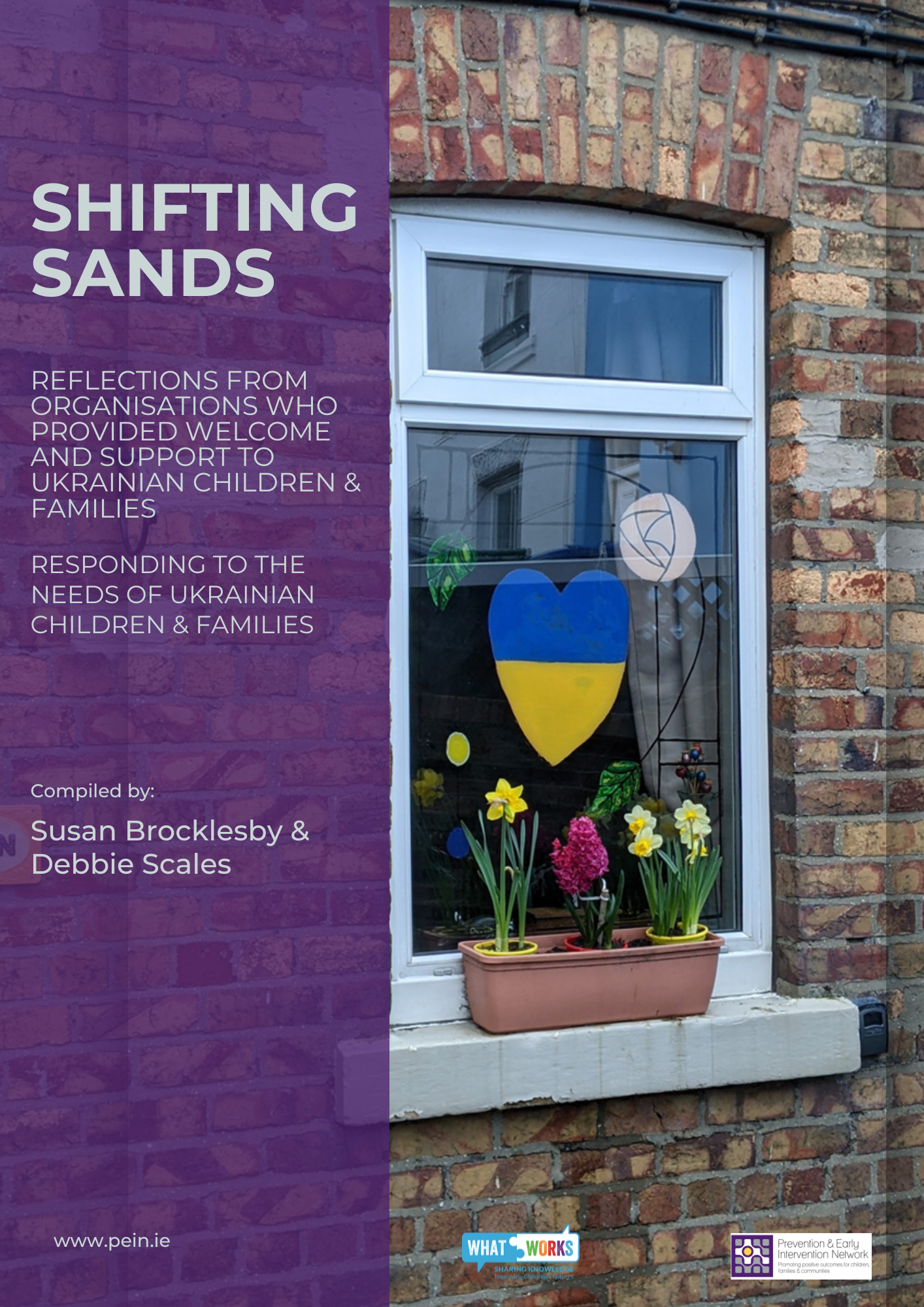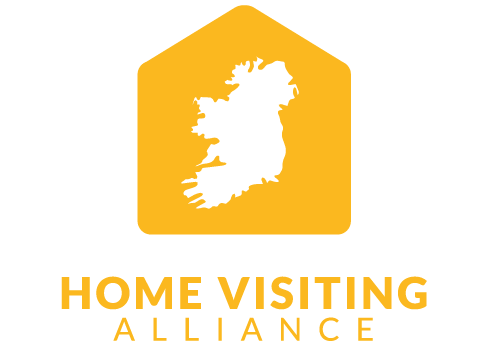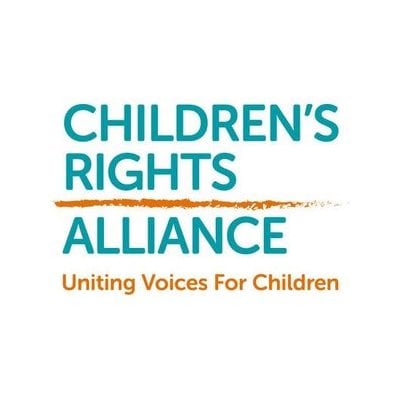
April 2017
1. Introduction
The Children’s Rights Alliance1 and the Prevention and Early Intervention Network2 welcome the opening of a national discussion on the role of Community Nursing and Midwifery, and are delighted to have the opportunity to make a submission to the consultation process.
This submission seeks to support and inform the consultation process on the development of a Community Nursing and Midwifery Response to an integrated model of care and provides recommendations on how to strengthen the model being proposed by the Department of Health.
This submission is concerned primarily with how to design a Community Nursing and Midwifery Response to an integrated model of care that organises and manages health and social services so that young children and their parents, from pre-birth onwards, get the treatment and care they need, when they need it, in ways that are user-friendly, achieve the desired results, fulfilling a child’s right to access preventative care, early intervention, and treatment should they require it.
The Children’s Rights Alliance and the Prevention and Early Intervention Network recognise the challenges faced by the Office of the Chief Nurse (CNO) and the Department of Health in achieving systems change in primary care. However, putting children’s rights and needs firmly at the centre decision-making in health and well-being policymaking, as well as in health service design and delivery, provides a clear and effective pathway to change. This should help to meet our national objective under Better Outcomes, Brighter Futures to ensure that children are active and healthy and have good physical and mental wellbeing.3 It will also help to meet the State’s international obligations under the UN Convention on the Rights of the Child which affirms that every child has the right to enjoy the highest attainable standard of physical and mental health.4 Article 24 of the Convention places particular emphasis on the development of primary health care.5
2. Balancing prevention and early intervention and acute care for children using children’s rights approaches and standards
Primary care is defined in Irish health policy as:
[…] an approach to care that includes a range of services designed to keep people well, from promotion of health and screening for disease to assessment, diagnosis, treatment and rehabilitation as well as personal social services. The services provide first-level contact that is fully accessible by self-referral and have a strong emphasis on working with communities and individuals to improve their health and social well-being.6
The Community Nursing and Midwifery services play a crucial role in urgent and planned care for children, and in keeping children well by implementing health promotion and preventative approaches. They are a key part of Ireland’s primary care architecture for ‘first level contact accessible by self referral’.7 It is crucial that the correct balance is achieved between these two aspects of the services.
It is important that prevention, promotion and protection are recognised as the most efficient and cost effective means of promoting health and wellbeing and reducing dependency on acute health and other public services. In particular, the development of a Community Nursing and Midwifery Response to an integrated model of care presents an opportunity for positive steps to be taken towards fulfilling the child’s right to access preventive healthcare, in line with obligations under European Union (EU) law8 and international human rights law.9 The model should be underpinned by the four key elements for the introduction of a rights based healthcare system: availability,10 accessibility,11 acceptability12 and quality.13
The UN Committee on the Rights of the Child has stressed that primary care should include the provision of information and services, as well as the prevention of illness and injury.14 Community6 based, early intervention and preventative healthcare services within a primary care structure are critical so that children can access effective services close to home and when they need them.15
The Committee on the Rights of the Child has recommended that the implementation of Article 24 must take into account all human rights principles, especially the guiding principles of the Convention namely;
- equality and non-discrimination (article 2)
- best interests (article 3)
- right to life (article 6)
- the voice of the child (article 12)
As recognised in the Department of Health’s policy proposal, a number of circumstances have caused the public health nursing services, for the most part, to limit the original purpose of offering health prevention, protection, and promotion.16 While acknowledging that one of the key impetuses to the development of this policy proposal was the real and pressing need to relieve the strain on over-burdened hospitals in the short and medium terms; it is imperative that in parallel, the longer term, preventative solutions to this problem are explored and promoted. It is important that the original purpose envisaged for the public health nursing service does not get lost by restricting the definition of “prevention” to the prevention of hospital admittance.
The proposed use of a demonstration site to test this reconfigured model of primary care is a welcome approach – it moves the policy proposal into the ‘real world’ and allows for a rigorous evidence-based approach to be taken to innovation. This demonstration needs to be adequately funded and evaluated Wolfe et al,17 analysing the literature on how best to reconfigure and integrate services within healthcare and between health and other sectors to improve child health and wellbeing outcomes, make a relevant point for the CNO’s work:
Integrated care services may be expensive to develop and test, and there may be a period of increased costs while improvements are confirmed or refuted through evaluation. The return on investment may be slow. Integrated care may deliver better quality of care and at less cost, but we do not yet fully know the answers. There should be fiscal space to test new services. Children’s health services and systems research is still an underdeveloped field, and although progress is slow there seems to be a growing recognition that capacity building and targeted research funding are essential.
The reconfiguration of community nursing and midwifery is not a short-term project. It takes time for social and economic benefits to accrue from shifting to prevention and early intervention from a reactive approach. Having the right data and evidence is very important, both in terms of outcome and process information.
It is important that, within this reconfiguration from early to reactive intervention, children and older people as groups both receive the care and treatment they need, when they need it. Future health policy and its implementation by the HSE needs to embed a life course approach. A life course approach to integrated care means that the distinct needs of each life stage are considered and catered for.18Effective prevention and early intervention has the potential to reduce or postponelater health needs, leading to a significant reduction over time in dependency on acute and long term care services
3. Importance of Prevention, Early Intervention and Wellbeing
The UN Committee on the Rights of the Child recognises that prevention and intervention strategies during early childhood have the potential to impact positively on young children’s current well-being and future prospects.19
Prevention is defined as stopping a problem from happening in the first place.20 Early intervention means acting at the first signs of trouble while treatment means responding once what could go wrong, has gone wrong.21 The human and economic benefits of early intervention and prevention programmes and approaches, by now well known, are summarised in the table below.

Better Outcomes, Brighter Futures: The National Policy Framework for Children and Young People 2014 – 2020 identifies prevention and early intervention as a transformational goal.23 The inter-departmental Healthy Ireland Strategy 2013-2035 24 seeks to mainstream Prevention and Early Intervention into the work of all government departments, while the current Programme for a Partnership Government seeks to change our approach from expensive reactive interventions to proactive supports and long-term planning starting from birth.25 The Department of Health and Children’s strategy document, Primary Care: A New Direction (2001) defines primary care as care that includes a range of services designed to keep people well, including the promotion of health and personal social services.26
Community-based, early intervention and preventative healthcare services within a primary care structure are critical so that children can access effective services close to home and when they need them.27 The proposed model should ensure that in line with the UN Convention on the Rights of the Child, Better Outcomes, Brighter Futures and Healthy Ireland, the prevention services are provided in community based settings.
Over the past decade Ireland has been at the forefront internationally in the design, development, implementation, and evaluation of effective prevention and early intervention programmes and approaches in communities and regional settings around the country.28 The learning from this experience should inform the development of the Protection, Promotion and Prevention section of the proposed service model. Community nurses and midwives should also be made aware of specific programmes operating in their area, as well as suitable programmes which are available for replication in new areas.29
The relationship between the four areas of the revised model of Community Health Nursing and Midwifery Service being proposed30 could be further clarified and made operationally more effective by the reorganisation of its constituent parts. The activities outlined under the Prevention, Promotion and Protection heading (Prevention – Population profiling, statistical analysis, Population health; Promotion – Policies for Obesity, Sexual health, Breastfeeding, Maternity strategy, smoking Alcohol and drugs, and: Protection – Safeguarding of Children and vulnerable adults) are integral elements of all three of the other areas in the model. In light of this, we propose that the Protection, Promotion and Prevention section of the model of should be incorporated into each of the other three areas of care in the model as follows:

Recommendations:
- Community-based, early intervention and preventative healthcare should be prioritised in the new model of Community Health Nursing and Midwifery Service.
- The learning and experience from proven Irish Prevention and Early Intervention Programmes31 should inform the development of the Protection, Promotion and Prevention section of the proposed service model.
- The relationship between the four areas of the revised model of Community Health Nursing and Midwifery Service should be reorganised for clarity and efficiency. The activities outlined under the Prevention, Promotion and Protection heading are integral elements of first response, short term care, and continuing/complex care, and should be incorporated into each of these three areas of care in the model.
4. Child and Family Community Nurses
The UN Committee on the Rights of the Child requires States to take all possible measures to improve perinatal care for mothers/ babies, reduce infant and child mortality, as well as create conditions that promote the well-being of all young children during this critical phase of their lives.32 The EU Commission’s Recommendation on Investing in Children highlights the importance of prevention and early intervention (PEI) in healthcare calling on States to ‘Invest in prevention particularly during early childhood years, by putting in place comprehensive policies that combine nutrition, health, education and social measures.’33
The Public Health Nurse (PHN) currently provides crucial early intervention and prevention services to children. The Public Health Nursing Services have their basis in the Health Act 1970 and are a key component in Better Outcomes Brighter Futures: The National Policy Framework for Children and Young People 2014 – 2020 and Healthy Ireland Strategy 2013-2035.34
The service to families and children, delivered through Public Health Nurses, has a central role to play in supporting families and children to achieve effective parenting, healthy development and improved outcomes.35 The Public Health Nursing Service also plays a key role in the area of child protection as recognised by the Institute of Community Health Nursing which noted that:
‘This role includes, among others, early identification of children at risk, multi-disciplinary engagement to identify solutions, ongoing monitoring of change in families and involvement in evaluation of progress.’36
It is a serious concern that the proposals as framed in the Consultation paper could dilute the role of the PHN in child health and wellbeing in favour of providing critical care. PHNs provide key early intervention and prevention services to children. This role needs to be prioritised in the Community Nursing and Midwifery Response to an Integrated Model of Care, and needs to be clearly defined. An audit of time usage by Public Health Nurses has shown the time they can dedicate to focus on child health is being impacted by other demands, such as early hospital discharges and an ageing population.37
In order to ensure that child health is prioritised in the new model, a specialist Child and Family Community Nurse Service should be introduced. Such a service should be located in the Protection, Promotion and Prevention pathway of the proposed Community Nursing and Midwifery Service. An example of this approach has already been piloted in the Longford Westmeath area.38
The UN Committee on the Rights of the Child has recommended that states should ensure an appropriately trained workforce of sufficient size to support health services for all children. Adequate regulation, supervision, remuneration and conditions of service are also required, including for community health workers. Capacity development activities should ensure that service providers work in a child-sensitive manner and do not deny children any services to which they are entitled by law. Accountability mechanisms should be incorporated to ensure that quality assurance standards are maintained.39
Adopting an approach that establishes Child and Family Community Nurses would ensure that children and their families would receive a more specialised and skilled service.
Recommendations:
- In order to ensure that child health is prioritised in the new model, a specialist Child and Family Community Nurse Service should be introduced.
- The role of the PHN in providing crucial early intervention and prevention services to children needs to be prioritised in the Community Nursing and Midwifery Response to an Integrated Model of Care and needs to be clearly defined.
4. Integration with Other Services
The State’s Primary Care Strategy states:
This [definition] means dealing with health problems at the lowest level of complexity. Primary care is the first point of contact that people have with the health and personal social services and should be available to all people regardless of who they are, where they live, what their income is or what health and social problems they may have. Primary care is the part of the system that ensures that services are co-ordinated and integrated across the boundaries of health and personal social care to the benefit of the consumer in terms of better quality, better outcomes, better cost-effectiveness and better health status.
The term ‘primary care’ is often used synonymously with ‘general practice’. While general practice is a key element, it is broader than general practice alone. It encompasses a wide range of health and personal social services delivered by a variety of professions. Primary care providers can make a significant difference not just in treating illness, but also in supporting people to care for themselves and their families, improving wellness, preventing illness and supporting those with long-term problems, from a health and social well-being perspective.40
While it is important that the model integrates with Primary Care Teams, there are other services operational in the community including early years settings, schools, community and voluntary organisations and Tusla that need to also be worked with in an integrated manner.
There are many examples of effective interagency working within the Area Based Childhood (ABC) programmes 41 which should be considered.
Thirteen areas in the programme provide the following supports (among others): provision of community-based antenatal and postnatal care and education; infant mental health support; supporting oral language development for children aged up to seven years; parent and family support; promoting youth mental health and wellbeing; promoting social and emotional development among children up to eight year olds; and improving literacy and numeracy among school-aged children.
The ABC areas are:
- Preparing for Life, Dublin Northside
- Tallaght West Childhood Development Initiative (CDI)
- Youngballymun, Ballymun
- Blue Skies Initiative, Clondalkin
- Dublin Docklands and East Inner City
- The Genesis Programme, Louth
- Better Finglas, Finglas
- Vision Beyond Poverty, Grangegorman
- Young Knocknaheeny, Knocknaheeny
- Supporting Parents and Early Childhood Services, Bray
- ABC Start Right, Limerick City
- Family Matters, Ballyfermot and Chapelizod
- Midlands Area Parenting Partnership
There is much that can be learned from the implementation, impact and cost benefit analysis evaluations of these programmes, and previous Prevention and Early Intervention Programmes, that can be used to further develop this community nursing and midwifery policy and can inform the implementation planning for the demonstration site.42 Further it would be a positive step towards fulfilling the Programme for Government commitment to mainstream the ABC Programmes.
The Department of Public Expenditure and Reform is in the process of establishing a new Prevention and Early Intervention Unit which will operate as an evaluation unit in relation to prevention and early intervention models in respect of children and also older people with chronic conditions. 43 This presents an opportunity for the Department of Health to learn from existing programmes and implement the learnings.
Health-service provision within schools provides an important opportunity for health promotion, to screen for illness, and increases the accessibility of health services for children attending school.44 It is important that the role of nursing in schools is included and integrated in the new model being proposed.
It is also important that the role of G.P. Practice Nurses is explored and integrated into any plan for developing the Community Nursing and Midwifery Service.45
The lack of a national child health system for the collection and analysis of data presents a barrier to integrated working between different services.46 There are five different systems currently in use and no standardised dataset.47 A parent-held Child Health Record is used in the HSE Mid-West, North-West and North-East regions, with a specially designed information system to back it up. This is often separate from, but linked to the immunisation system in these areas. Despite a highly positive evaluation of the pilot sites, there has been no rollout of the Record.48 There is no national health identifier and this makes linking data from different sources problematic.49
Recommendations:
- Systems and protocols should be put in place to ensure that the model can working in an integrated way with other services operational in the community including early years settings, schools, community and voluntary organisations and Tusla.
- Progress the National Health Identifier to enable integrated working between different services working with children.
- The parent-held Child Health Record should be available to all parents.
1 The Children’s Rights Alliance unites over 100 members working together to make Ireland one of the best places in the world to be a child. We change the lives of all children in Ireland by making sure that their rights are respected and protected in our laws, policies and services.
2 The Prevention and Early Intervention Network (PEIN) is a network of evidence-based practice, advocacy and research organisations across the Republic of Ireland that share a commitment to improving outcomes for children, young people and their communities. The majority of our members specialise in delivering prevention and early intervention programs to help children, families and communities to realise their potential. Their network website www.pein.ie showcases more than 40 such programs in the Republic of Ireland which have been delivered and independently validated.
3 Department of Children and Youth Affairs, Better Outcomes, Brighter Futures: The National Policy Framework for Children and Young People 2014 – 2020 (DCYA 2014) 49.
4 A child’s right to health is set out in UN Convention on the Rights of the Child (20 November 1989) 1577 UNTS 3 (UNCRC) Art 24.
5 ibid Art 24 (b).
6 Department of Health and Children, Primary Care – A New Direction (2001 Department of Health and Children) 15.
7 ibid.
8 European Union Charter of Fundamental Rights (22 October 2012) OJ C 326, Art 35: ‘Everyone has the right of access to preventive health care and the right to benefit from medical treatment under the conditions established by national laws and practices. A high level of human health protection shall be ensured in the definition and implementation of all Union policies and activities’.
9 UN Convention on the Rights of the Child (20 November 1989) 1577 UNTS 3 (UNCRC) Art 24; International Covenant on Economic, Social and Cultural Rights (16 December 1966) 993 UNTS 3 (ICESCR) Art 12.
10 “Functioning public health and health-care facilities, goods and services, as well as programmes, have to be available in sufficient quantity within the State party. The precise nature of the facilities, goods and services will vary depending on numerous factors, including the State party’s developmental level. They will include, however, the underlying determinants of health, such as safe and potable drinking water and adequate sanitation facilities, hospitals, clinics and other health-related buildings, trained medical and professional personnel receiving domestically competitive salaries, and essential drugs, as defined by the WHO Action Programme on Essential Drugs” UN Committee on Economic, Social and Cultural Rights (CESCR), General Comment No. 14: The Right to the Highest Attainable Standard of Health (Art. 12 of the Covenant), 11 August 2000, E/C.12/2000/4.
11 Health facilities, goods and services have to be accessible to everyone without discrimination, within the jurisdiction of the State party. This includes the principles of non-discrimination, physical accessibility and affordability. UN Committee on Economic, Social and Cultural Rights (CESCR), General Comment No. 14: The Right to the Highest Attainable Standard of Health (Art. 12 of the Covenant), 11 August 2000, E/C.12/2000/4.
12 “All health facilities, goods and services must be respectful of medical ethics and culturally appropriate, i.e. respectful of the culture of individuals, minorities, peoples and communities, sensitive to gender and life-cycle requirements, as well as being designed to respect confidentiality and improve the health status of those concerned” UN Committee on Economic, Social and Cultural Rights (CESCR), General Comment No. 14: The Right to the Highest Attainable Standard of Health (Art. 12 of the Covenant), 11 August 2000, E/C.12/2000/4.
13 “As well as being culturally acceptable, health facilities, goods and services must also be scientifically and medically appropriate and of good quality. This requires, inter alia, skilled medical personnel, scientifically approved and unexpired drugs and hospital equipment, safe and potable water, and adequate sanitation” UN Committee on Economic, Social and Cultural Rights (CESCR), General Comment No. 14: The Right to the Highest Attainable Standard of Health (Art. 12 of the Covenant), 11 August 2000, E/C.12/2000/4.
14 UNCRC ‘General Comment No. 15 on the Right of the Child to the Enjoyment of the Highest Attainable Standard of Health (Art 24)’ (2013) UN Doc CRC/C/GC/15 para 26.
15 Sheila Greene ‘Getting the First Steps Right’ (Trinity Research Centre, 3 December 2015) <http://health.gov.ie/wp-content/uploads/2011/06/Presentation-by-Sheila-Greene-Children%E2%80%99s-Research-Centre-Trinity-College-Dublin.pdf>accessed 6 January 2016.
16 A. Phelan and S McCarthy, Missed care: Community Nursing in Ireland (2016 University College Dublin and the Irish Nurses and midwives Organisation).
17 Ingrid Wolfe, Claire Lemer, Hilary Cass Wolfe et al. ‘Integrated care: a solution for improving children’s health? Arch Dis Child’ 2016 Vol 101 No 11,.
18 ibid 12
19 UNCRC ‘General Comment No.7: Implementing child rights in early childhood’ (2006) UN Doc CRC/C/G/GC/7/Rev.1 para 8.
20 M. Little and S. Sodha, Prevention and Early Intervention in Children’s Services (2012 NESTA) 3.
21 ibid.
22 Karoly, Lynn et al Early childhood interventions – proven results, future promise (2005 RAND); Paul Kershaw, et al 15 by 15 – a comprehensive policy framework for early human capital investment. (2009 University of British Columbia); Sarah Wise, et al The efficacy of early interventions. (2005 Melbourne, Australian Institute of Family Studies); Graham Allen, Early intervention – smart investment, massive savings (2011 Her Majesty’s Government).
23 Department of Children and Youth Affairs, Better Outcomes, Brighter Futures: The National Policy Framework for Children and Young People 2014 – 2020 (DCYA 2014)
24 Department of Health, Healthy Ireland Strategy 2013-2035 (2013 Department of Health).
25 Government of Ireland (2016) A Programme for a Partnership Government
26 Deaprtment of Health, Primary Care, A New Direction, Quality and Fairness – A Health System for You, Health Strategy (2001 Department of Health) 15.
27 Sheila Greene ‘Getting the First Steps Right’ (Trinity Research Centre, 3 December 2015) <http://health.gov.ie/wp-content/uploads/2011/06/Presentation-by-Sheila-Greene-Children%E2%80%99s-Research-Centre-Trinity-College-Dublin.pdf>accessed 6 January 2016.
28 For a selection of Irish evidence of the effectiveness of prevention and early intervention programmes see: Centre for Effective Services, Improving child behaviour; Child health and development; Children’s learning; Parenting; Promoting inclusion (2013 Series); S. Rochford, N. Doherty and S. Ownes, Prevention and Early Intervention in Children and Young People’s Services: Ten Years of Learning (Centre for Effective Services); S McGilloway et al The Incredible Years Ireland study (2012 Archways); University College Dublin Geary Institute, Preparing for life early childhood intervention: assessing the early impact of PfL at 6 months/12 months/18 months/24 months (2011, 2012, 2013, 2013 (series)); McGilloway et al, Reducing child conduct disordered behaviour and improving parental mental health in disadvantaged families: a 12-month follow-up and cost analysis of a parenting intervention, European Journal of Child Adolescent Psychiatry, January 2014; N. Hayes et al, Evaluation of the Early years programme of the Childhood Development Initiative (2013 Childhood Development Initiative); P. Dolan et al, Big Brothers Big Sisters of Ireland: evaluation study (2011 Child and Family Research Centre, National University of Ireland Galway); M. Millar, Making a difference – an independent evaluation of the Incredible years programme in pre-schools in Galway city; Fives, Allyn et al, Evaluation of the effectiveness of Barnardos’ Wizards of Words reading programme (2013 Barnardos).
29 For details of proven prevention and early intervention programmes around Ireland see Prevention and Early Intervention, <http://www.pein.ie/how-to/ > accessed 25 April 2017.
30 Amended version of Section 2.3, page 16, Figure 1, received from the Department of Health on 21 April 2017.
31 For details of proven prevention and early intervention programmes around Ireland see Prevention and Early Intervention, <http://www.pein.ie/how-to/ > accessed 25 April 2017.
32 UNCRC ‘General Comment No.7: Implementing child rights in early childhood’ (2006) UN Doc CRC/C/G/GC/7/Rev.1 para 10.
33 European Commission ‘Recommendation on Investing in Children: breaking the cycle of disadvantage’ (20 February 2013) C(2013) 778. para 6.3.2
34 Department of Health, Healthy Ireland Strategy 2013-2035 (2013 Department of Health)
35 Institute of Community Health Nursing, Best Option for Children’: Discussion Paper on Child Health. (2013 ICHN) 4.
36 Institute of Community Health Nursing, Best Option for Children’: Discussion Paper on Child Health. (2013 ICHN).
37 S. Denyer, Report on the Audit of the Child Health Screening and Surveillance (CHSS) Programme. (2009 Health Service Executive).
38 Department of Health ‘Nursing & Midwifery Newsletter Dublin Mid-Leinster’ <http://www.hse.ie/eng/about/Who/ONMSD/NMPDU/NMPDUDSkilwicklow/DMLNEWSSept.pdf> accessed 25 April 2017.
39 UN Committee on the Rights of the Child (2013) General Comment No. 15: the right of the child to the enjoyment of the highest attainable standard of health CRC/C/GC/15. Para 27
40 Department of Health and Children, Primary Care – A New Direction (2001 Department of Health and Children) 15
41 Department of Children and Youth Affairs, Area Based Childhood Programmes <https://www.dcya.gov.ie/viewdoc.asp?fn=/documents/National_Childrens_Advisory_Council_.htm> accessed 25 April 2017.
42 Department of Children and Youth Affairs, Area Based Childhood Programmes <https://www.dcya.gov.ie/viewdoc.asp?fn=/documents/National_Childrens_Advisory_Council_.htm> accessed 25 April 2017.
43 ibid.
44 UN Committee on the Rights of the Child (2013) General Comment No. 15: the right of the child to the enjoyment of the highest attainable standard of health CRC/C/GC/15. Para 36
45 Irish Practice Nurses Association, About the IPNA < http://irishpracticenurses.ie/about-us/> accessed 25 April 2017.
46 DCYA (2013) Right From the Start – Report of the Expert Advisory Group on the Early Years Strategy. Dublin: DCYA
47 ibid.
48 ibid.
49 A National Health Identifier for each individual in Ireland is under development. Department of Health, ‘Individual Health Identifiers’ < http://health.gov.ie/future-health/tackling-the-capacity-deficit/individual-health-identifiers/> accessed 26 April 2017.
continue reading
Related Posts
An Economic Study, conducted by Professor Orla Doyle, UCD, which makes the economic case for investing in Home Visiting programmes […]
Research reviewing the provision of Home Visiting Services for families with babies and young children was launched earlier this week […]
Our Shifting Sands webinar is now available to view HERE. Dive into a wealth of knowledge and insights on […]

